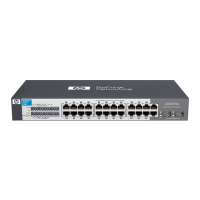1-4
Introducing the Switch
Front of the Switch
Network Ports
■ 8, 16, or 24 auto-sensing 10/100/1000Base-T ports.
All these ports have the “Auto-MDIX” feature, which means that you can
use either straight-through or crossover twisted-pair cables to connect
any network devices to the switch.
■ (1410-24G Switch only) Two dual-personality ports for either 10/100/
1000Base-T RJ-45 uplinks, or mini-GBIC (SFP) slots for fiber uplinks.
LEDs
The front panels of the switches provide status LEDs for system monitoring.
Table 1-2 details the functions of the LED indicators.
Table 1-2. Switch Status LEDs
Switch LEDs State Meaning
Power
(green)
On The internal power supply is working properly.
Off No power connection. The switch is NOT receiving power.
Port LEDs
Link/Act
(green)
On The port is enabled and receiving a link indication from the connected device.
Off One of these condition exists:
• no active network cable is connected to the port
• the port is not receiving link beat or sufficient light
Flashing
1
Indicates that there is network activity on the port.
Speed
(green)
On Indicates the port is operating at 1000 Mbps.
Off Indicates the port is operating at 10 or 100 Mbps.
1
The flashing behavior is an on/off cycle once every 0.083 seconds approximately.

